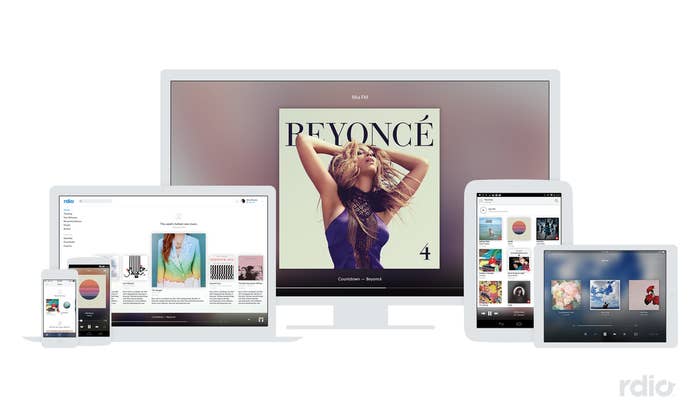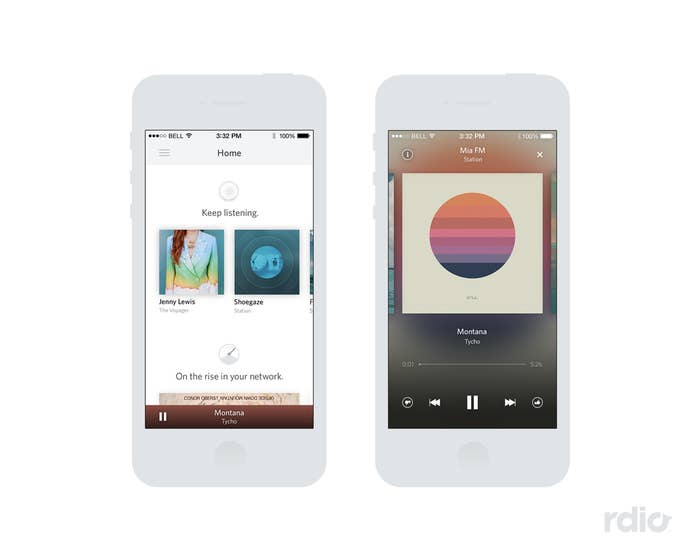
Rdio, the music streaming app most often compared to Spotify, rolled out a series of updates today that shifts the focus from the company's subscription product to the free stations that were made available to users earlier this summer.
When Rdio launched in 2010 users were given access to a limited amount of songs to stream for free before being prompted to upgrade to the paid product. But several months after Cumulus Media, the second largest radio operator in the U.S., bought a stake in the company in 2013, Rdio began offering an ad-supported streaming music service. Users could hand pick songs to put into a playlist or choose an artist, genre or theme that the app would algorithmically create stations based upon. Alternatively, Rdio curated personal stations based on a users' activity (favorites, history, etc.) that other users could also follow, listen to or find stations that are similar to it.
The latest iteration of Rdio brings all of that to the forefront in an apparent effort to reposition where the company stands among competitors. Whereas the platform's free streaming stations used to be in its own tab, the stations are now an upfront and integral part of the user experience. Users will be greeted by a scrolling feed of recommended stations based on their likes, listening history, new music or what's trending among the network of people the user follows. It's a personalized radio experience, much like that of Pandora, as Marc Ruxin emphasized in an interview with BuzzFeed. Ruxin joined Rdio as chief operating officer in 2014 when the company acquired TasteMakerX, the music service he founded.
"We believe a great music service should let you listen to music any way you want to, and no other service combines a great lean forward listening experience with a great lean back listening experience," a Rdio spokesperson wrote to BuzzFeed in a follow up email. "We're doubling down on our stations efforts to create a best-in-class stations service to complement our existing best-in-class on-demand service, and believe a robust free listening experience will drive listener acquisition, engagement and conversation."
Still, many of the services still mirror that of Spotify, which has seen a great deal of success since its launch in the United States in 2011. Most recently, Spotify reportedly reached 30 million free users and an additional 10 million paying users. Though Rdio hasn't publically disclosed how many users it has, Ruxin told BuzzFeed about 25 percent are paid subscribers.
It comes as no surprise that many have compared the two services. In a side-by-side analysis Spotify has so far generally reigned supreme possibly primarily because Spotify has long offered a free streaming service alongside its subscription product. In the words of Yahoo Tech columnist Alyssa Bereznak, "Spotify is to Beyoncé as Rdio is to Solange."

Using both apps side-by-side won't reveal much about their differences. Rdio and Spotify are comparable in terms of the catalog of music each carries (Rdio has 30 million and Spotify has 20 million) and both allow users to create playlists and stations based on artists. In creating an artist-based station, the algorithms proved to be fairly consistent offering the same related artists or songs. (Rdio continues to use The Echo's Nest, the recommendation service Spotify acquired, and plans to use it for a few more months before employing the company's proprietary recommendation software.)
However, only Rdio curates these personal stations called "You FM" and has a more robust focus on the social aspect of the app. Where Spotify emphasizes following Facebook friends and their playlists, Rdio immediately prompts new users with the option to follow several influencers, DJs and popular stations. When skimming through different stations and categories, users can see which stations the people they've followed have listened to. Additionally, in the mobile app Rdio allows users to listen to individual songs on-demand and Spotify only allows users to shuffle songs.
"Stories are built around the listener music preferences, friends' recent activity, recommendations from Rdio experts and more," Rdio wrote in a followup statement emailed to BuzzFeed. "Home replaces Recent Activity and expands upon the stories you see from the people you follow."
Adding to that, Cumulus Media is in the process of migrating the company's 440 radio stations to Rdio. (The company expects the stations to appear on Rdio early next year.) This attempt to be seen as a personal radio service might just be Rdio's way of trying to step out of Spotify's shadow. In an interview with BuzzFeed, Ruxin made little mention of Spotify unless otherwise prompted and instead honed in on the difference in service Rdio provided compared to Pandora. For example, Ruxin said, Pandora's paid product is not much different than its free service.
"What you can do in the [Rdio] product unlike Pandora is you can easily upgrade," Ruxin said. "You can pay $9.99 and then you can access anything, you can download everything from the stations to listen to it an offline mode. The more you use the service the smarter you get, recommending people to you. The only way to get a different Pandora experience is to buy away the ads. "
Whether this new comparison will stick has yet to be seen, but Ruxin does admit not introducing a free streaming service when Rdio first launched may have been an oversight — one that in the end could possibly cost them the battle against Spotify.
